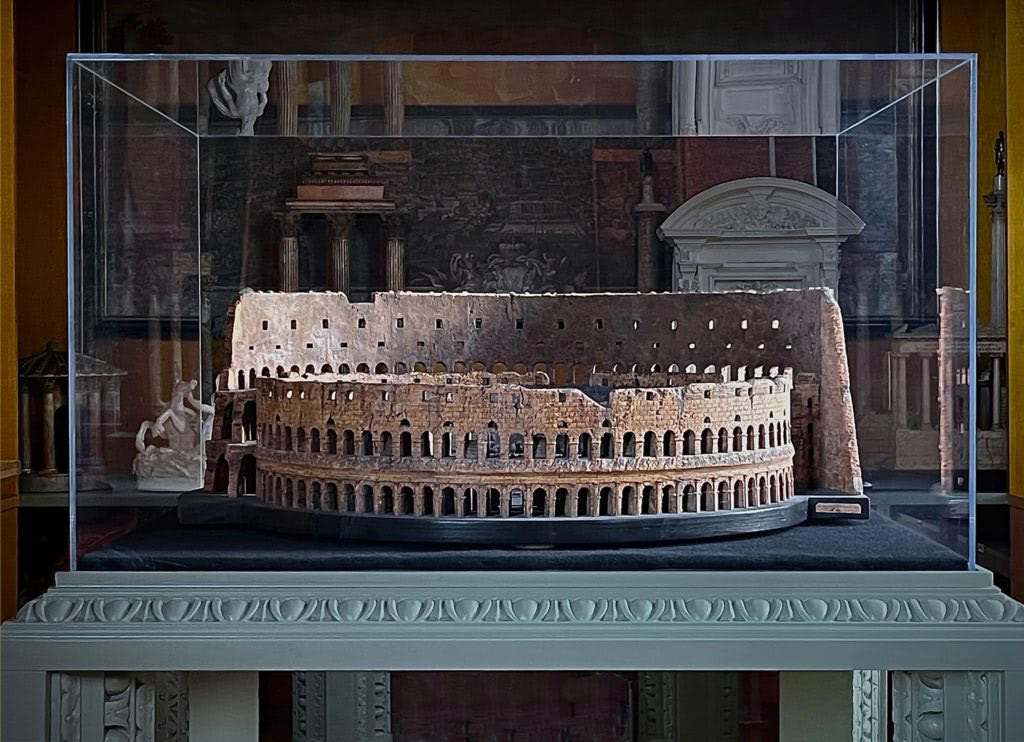Piraneseum partners Lucia Howard and David Weingarten are architects; and co-founders, 40 years ago, of Ace Architects, a firm noted for buildings at once original and emphatic. Their work is widely published; and Lucia and David have twice been included in the AD100, Architectural Digest’s lineup of “the world’s foremost designers”.

The pair have long been interested in architectural pictures and models; especially in 17th and 18th century Italian ruins paintings and 19th century Roman architectural models (where subjects often run to ruins). For Lucia and David, these objects are now especially resonant and portentous; portrayals of the end of an ancient empire and, simultaneously, intimations of our own modern prospects.
At the literal center of Piraneseum’s extensive collection of 16th-19th century architectural pictures and models is an impressive, carved cork replica of the Colosseum, crafted in the 1840’s by Roman artisan Luigi Carotti. History records that Carotti fashioned two other examples of this model (among a variety of other cork reductions), including one now lost and another currently in the collection of the Lindenau Museum, in Altenburg, Germany.

When accessioned, in 2018, the model was in a poor state of conservation. Piraneseum located the only craftsperson still working in the antique medium of cork architectural models, Dieter Coellen. In what must be described as extreme serendipity, Dieter not only lives just a few kilometers from Cologne, Germany, where the model was uncovered, but had very recently undertaken an extensive conservation of the Lindenau Museum’s Carotti-crafted Colosseum model. Thus, he could not have been better prepared for the task ahead. His work, as you can see, is spectacular, and his fascinating, painstaking process carefully documented on his blog.
Our work then commenced. Most important was to fashion a setting for this model at once protective and allowing visitors the best possible views.
Unlike other models in the collection, which are very largely made of carved stone and cast, patinated metals, the Colosseum model’s surface is delicate and the material’s tiny fissures and voids (which so well emulate ancient stone) are natural collectors of dust and grime. To retard degradation, it is also important that cork be kept in a constant environment, with relative humidity at fifty per cent, and temperature at seventy degrees.
With this in mind, we settled on a closed, gasketed vitrine, whose atmosphere is passively regulated, a first for the collection. The design of the stand, related to the collection’s other display structures, incorporates carved 18th century, egg and dart mouldings designed by English architect William Kent, originally installed at Chatsworth House. Fitted into these antique elements is a repository for Pro Sorb beads, which control humidity levels. Off-gassing from the wood deck into the vitrine enclosure is prevented by Marvel Seal, an aluminized nylon and polyethylene barrier film.
This left, of course, the very most important question of the vitrine cover itself.

Over the past thirty years, objects drawn exclusively from the collection have formed exhibitions in museums across the United States, including the San Francisco Museum of Modern Art, Art Institute of Chicago, Octagon Museum, Museum of the City of New York and, half a dozen times, SFO Museum. Not long ago, we donated the collection’s three thousand plus 20th century architectural models to the National Building Museum.
Querying our museum contacts, Optium Museum Acrylic® by Tru Vue was highly recommended for the task at hand. Our due diligence left us impressed with Optium’s UV resistance, clarity, and minimal reflectance.
The best material is only as good as the quality of its fabrication and installation. Tru Vue put us in touch with Architectural Plastics, a local shop, whose expertise (even artistry) with Optium was an important part of the project’s success.

Still, nothing substitutes for seeing a completed installation; and the finished effect is a thoroughgoing pleasure. Beneath its Optium Museum Acrylic cover, Carotti’s Colosseum looks great; better even than it appeared without the cover. We are at somewhat of a loss to explain this, but there is a way in which the model is rendered in slightly greater contrast and, related to this, greater focus. No doubt, Optium’s engineers have an explanation.

Share this Article:
This article is intended for educational purposes only and does not replace independent professional judgment. Statements of fact and opinions expressed are those of the author(s) individually and, unless expressly stated to the contrary, are not the opinion or position of Tru Vue or its employees. Tru Vue does not endorse or approve, and assumes no responsibility for, the content, accuracy or completeness of the information presented.
